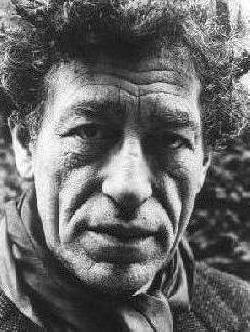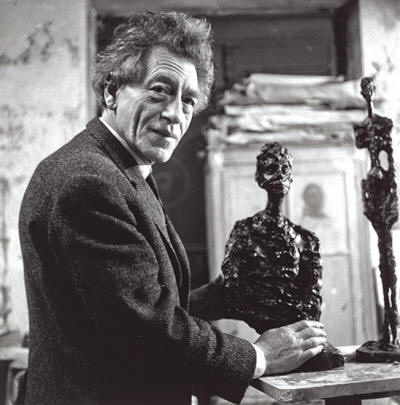

Queer Places:
46 Rue Hippolyte Maindron, 75014 Paris, France
Cemetery of the Church of San Giorgio
Borgonovo, Bezirk Maloja, Graubünden, Switzerland
 Alberto Giacometti (10 October 1901 – 11 January 1966) was a Swiss sculptor, painter, draftsman and printmaker. Beginning in 1922, he lived and worked mainly in Paris but regularly visited his hometown Borgonovo to see his family and work on his art.
Giacometti was one of the most important sculptors of the 20th century. His work was particularly influenced by artistic styles such as Cubism and Surrealism. Philosophical questions about the human condition, as well as existential and phenomenological debates played a significant role in his work.[5] Around 1935 he gave up on his Surrealistic influences in order to pursue a more deepened analysis of figurative compositions. Giacometti wrote texts for periodicals and exhibition catalogues and recorded his thoughts and memories in notebooks and diaries. His critical nature led to self-doubt about his own work and his self-percieved inability to do justice to his own artistic vision. His insecurities nevertheless remained a powerful motivating artistic force thoughout his entire life.[6]
Between 1938 and 1944 Giacometti's sculptures had a maximum height of seven centimeters (2.75 inches).[7] Their small size reflected the actual distance between the artist's position and his model. In this context he self-critically stated: "But wanting to create from memory what I had seen, to my terror the sculptures became smaller and smaller".[8] After World War II, Giacometti created his most famous sculptures: his extremely tall and slender figurines. These sculptures were subject to his individual viewing experience—between an imaginary yet real, a tangible yet inaccessible space.[9]
In Giacometti's whole body of work, his painting constitutes only a small part. After 1957, however, his figurative paintings were equally as present as his sculptures. His almost monochromatic paintings of his late work do not refer to any other artistic styles of modernity.[10]
Alberto Giacometti (10 October 1901 – 11 January 1966) was a Swiss sculptor, painter, draftsman and printmaker. Beginning in 1922, he lived and worked mainly in Paris but regularly visited his hometown Borgonovo to see his family and work on his art.
Giacometti was one of the most important sculptors of the 20th century. His work was particularly influenced by artistic styles such as Cubism and Surrealism. Philosophical questions about the human condition, as well as existential and phenomenological debates played a significant role in his work.[5] Around 1935 he gave up on his Surrealistic influences in order to pursue a more deepened analysis of figurative compositions. Giacometti wrote texts for periodicals and exhibition catalogues and recorded his thoughts and memories in notebooks and diaries. His critical nature led to self-doubt about his own work and his self-percieved inability to do justice to his own artistic vision. His insecurities nevertheless remained a powerful motivating artistic force thoughout his entire life.[6]
Between 1938 and 1944 Giacometti's sculptures had a maximum height of seven centimeters (2.75 inches).[7] Their small size reflected the actual distance between the artist's position and his model. In this context he self-critically stated: "But wanting to create from memory what I had seen, to my terror the sculptures became smaller and smaller".[8] After World War II, Giacometti created his most famous sculptures: his extremely tall and slender figurines. These sculptures were subject to his individual viewing experience—between an imaginary yet real, a tangible yet inaccessible space.[9]
In Giacometti's whole body of work, his painting constitutes only a small part. After 1957, however, his figurative paintings were equally as present as his sculptures. His almost monochromatic paintings of his late work do not refer to any other artistic styles of modernity.[10]
During World War II, Giacometti took refuge in Switzerland. There, in 1946, he met Annette Arm, a secretary for the Red Cross. They married in 1949.[13] After his marriage his tiny sculptures became larger, but the larger they grew, the thinner they became. For the remainder of Giacometti's life, Annette was his main female model.[13] His paintings underwent a parallel procedure. The figures appear isolated and severely attenuated, as the result of continuous reworking. He frequently revisited his subjects: one of his favourite models was his younger brother Diego Giacometti.[14]

Paul Rodocanachi (seated in the center) with (from left to right) Alberto Giacometti, Jean-Michel Frank, Emilio Terry, Christian Bérard, Adolphe Chanaux e Diego Giacometti
, by François Kollar

Alberto Giacometti, 1966, by Gisèle Freund
Giacometti died in 1966 of heart disease (pericarditis) and Chronic Obstructive Pulmonary Disease at the Kantonsspital in Chur, Switzerland. His body was returned to his birthplace in Borgonovo, where he was interred close to his parents. With no children, Annette Giacometti became the sole holder of his property rights.[13] She worked to collect a full listing of authenticated works by her late husband, gathering documentation on the location and manufacture of his works and working to fight the rising number of counterfeited works. When she died in 1993, the Fondation Giacometti was set up by the French state. In May 2007 the executor of his widow's estate, former French foreign minister Roland Dumas, was convicted of illegally selling Giacometti's works to a top auctioneer, Jacques Tajan, who was also convicted. Both were ordered to pay €850,000 to the Alberto and Annette Giacometti Foundation.[17]
My published books: